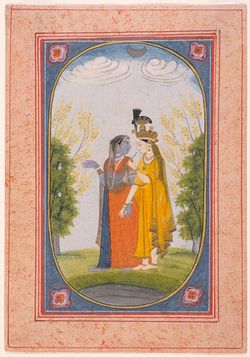The pictorial art of Kangra is one of the finest gifts of India to the art-world. This great art originated in a small hill state ‘Guler’ in the Lower Himalayas in the first half of the eighteenth century when a family of Kashmiri painters trained in Mughal Style of painting sought shelter at the court of Raja Dalip Singh (r. 1695-1741) of Guler. The new arrivals mingled with the local artists and were greatly influenced by the atmosphere of the hills. Instead of painting flattering portraits of their masters and love scenes, the artistes adopted themes of eternal love between Radha and Krishna. The paintings were naturalistic and employed cool, fresh colors. The colors were extracted from minerals, vegetables and possessed enamel-like luster. Verdant greenery of the landscape, brooks, springs were the recurrent images on the miniatures.[1]
Contents
Maturity
The Kangra paintings reached their maturity during the reign of Maharaja Sansar Chand (1775-1823 AD.). Maharaja Sansar Chand was a great patron of Kangra art. Being a liberal patron, the painters working at his atelier received large commissions while others accepted a permanent settlement in the form of lands. He was also an ardent devotee of lord Krishna and used to commission artists to paint subjects based on the loves and life of Lord Krishna.[2]
Theme
The focal theme of Kangra painting is Sringar (the erotic sentiment). The subjects seen in Kangra painting exhibit the taste and the traits of the life style of the society of that period. Bhakti cult was the driving force and the love story of Radha and Krishna was the main source of spiritual experience, which was also the base for the visual expression. Bhagvata Purana and the love poems Gita-Govinda of Jaidev were the most popular subjects dealing with the legends and the amorous plays of Radha and Krishna symbolising soul’s devotion to God. In some miniatures, the blue-god Krishna is seen dancing in the lush woodlands and every maiden’s eye are drawn to him. Krishna subjects, known commonly as Krishna-lila predominate, while the themes of love, inspired by the nayaks and nayikas and baramasa enjoyed great favour. The sentiment of love remained the inspiration and the central theme of Pahari painting.[1]





